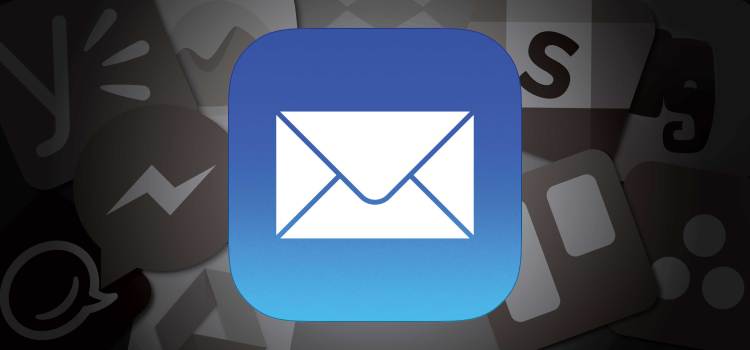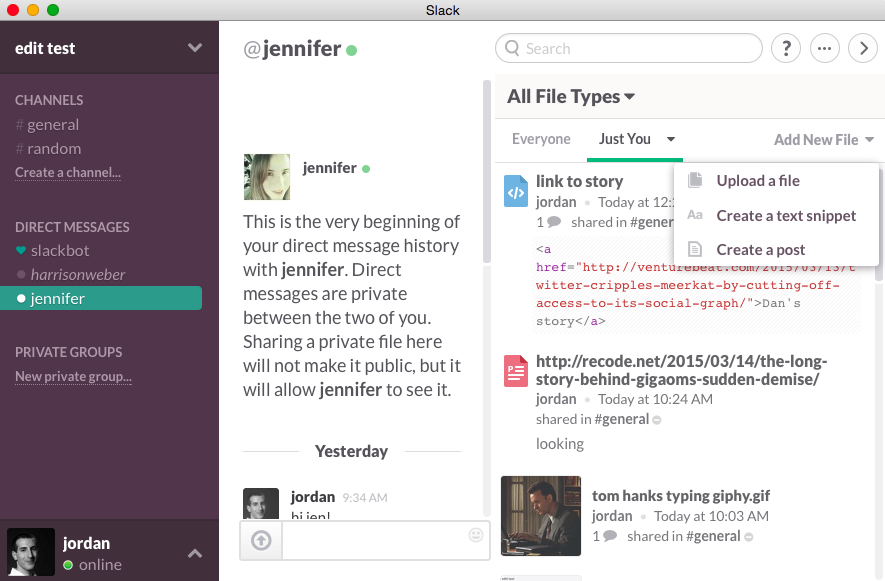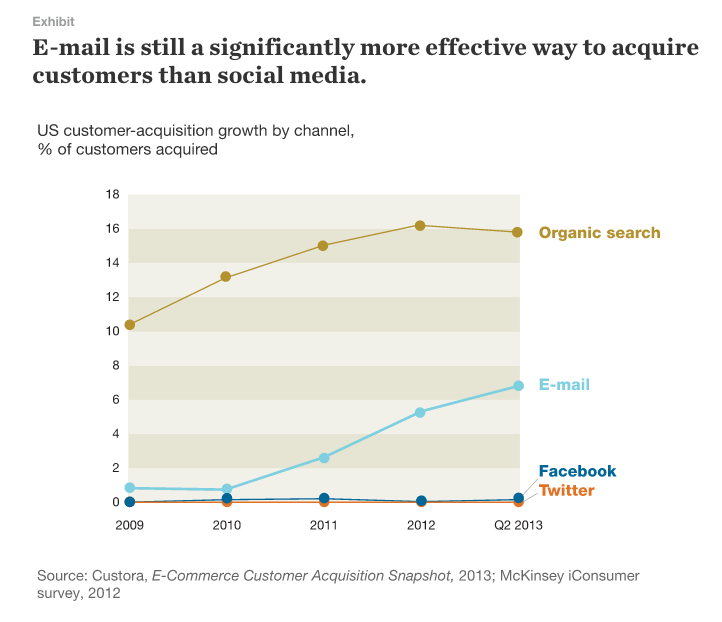Competing for your attention
Email is facing an onslaught of services determined to pull you away from your inbox — promising to bring normalcy to your life, while likely chomping at the bit for the treasure chest of data that’ll accompany you. Although email addresses are required to authenticate with these offerings, the activity takes place in an app, accommodating the behaviors we’re now accustomed to.
Stewart Butterfield once acknowledged that “email isn’t going anywhere,” a powerful statement coming from the cofounder and chief executive of Slack, the productivity app that has seen usage explode since its creation in 2013. He even jokingly referred to email as “the cockroach of the internet,” a phrase that Bonforte also used during our interview. But while stipulating that the inbox remains relevant, Slack believes it’s weak when dealing with team communication, an area where Slack intends to (pardon the pun) pick up the slack.
“Companies have a choice now: They don’t have to do the lowest common denominator for their asset, people,” said Slack chief marketing officer Bill Macaitis. “Slack is part of this overall trend, moving away from email to messaging. If you look now, no one under 30 is creating email addresses. They’re on Snapchat, Facebook Messenger, etc.”
Instead of asking people to send emails back and forth, stockpiling replies and cluttering inboxes with one-word statements, memes, GIFs, photos, and videos, Slack thinks it provides a better workflow for managing internal and team communications. Its success centers around the popularity of real-time communication, so you don’t have to sift through emails to find out whether your coworkers want to go to lunch or see what someone said about a project update.
“Messaging is very elegant and simple, taking away the ‘to’, ‘from’, date stamp, greeting, salutation, and all the other things that takes an extra second to put together,” Macaitis said. “I think there’s a natural evolution or transition. There will be a landscape where email and messaging work harmoniously together.”
A part of Slack’s strategy is integrations with third-party applications — there are currently 280 apps in its directory, accessible to its 2.3 million daily active users. Macaitis views Slack as an operating system for teams, offering best-of-breed apps right within its platform.
“More companies are communicating with each other on Slack. People are creating channels within their Slack teams to communicate with vendors, partners, and employees. They’ve done ad projects where they’re sending feedback, comps, etc. to agencies enabling them to move faster than traditional email. We’re starting to see this use case become prevalent. It’s great for companies because it’s not clogging up inboxes and it’s getting [information] into the right channels to the right people,” Macaitis claimed.
Peter Martinazzi, Facebook’s director of product management for the social network’s messaging service, sees a similar trend. “When we remove friction to communication, people communicate more,” he said. While he acknowledges that email still sees a lot of interaction, he doesn’t think that it’s the only communication channel companies should avail themselves of. “The current state of the world is that you interact in multiple ways. Even though a certain business takes this multiple channels approach, individuals may bias themselves [in favor of] one. On a relationship basis, there’s a default place to go to communicate, and for a lot of businesses, that may become Facebook Messenger.”
Facebook Messenger now counts more than 1 billion monthly active users, and over the past couple of years, it has expanded from peer-to-peer communication to include business-to-consumer messaging. The company believes that instead of the sluggish response times associated with business email, customers will have better interactions through messaging.
“Overall, people are communicating a lot more because friction is removed,” Martinazzi shared. He cites the changing communication landscape in which phones are no longer attached to a physical location: “With a mobile phone, I’m not calling a location, I’m calling you.”
And he believes the same can be said about an email address. “An email address is not a person,” he said. “When I open up Messenger, I smile because I see faces, and that’s different. Email feels like there’s tasks that you have to complete. It doesn’t have the life and the people view that messaging has.”
Facebook Messenger isn’t alone in its effort to simplify information-sharing, as it has followed WeChat in creating an all-encompassing communication platform, with others — like Kik and Line — joining in as well. Facebook’s two powerhouse messaging apps are now processing more than 60 billion messages a day, which is three times more than SMS.
It’s easy to see the appeal of messaging over email: You save the time of having to remember someone’s email address, and sending a message feels more like walking up to someone and talking to them directly. But messaging apps are not without their own issues, such as problems with organization, searching, and the fact that should these services shutter for whatever reason, that history is lost.
Martinazzi admits that messaging is still just scratching the surface in terms of capabilities. He said that providing better tools “means we’re going to communicate more and more. It helps people become better connected. I think we’re just at the beginning and there’s so much more we can do here.”
‘A core part of how companies interact’
Although it seems email is on the defensive, one group that isn’t ready to abandon it is businesses, specifically when it comes to the impact of marketing. In 2014, 55 percent of companies generated more than 10 percent of their sales through email, and brands indicated that this medium was “almost 40 times better at acquiring new customers compared to Twitter and Facebook.”

Above: Marketers agree that email generates significantly higher return on investment.
“Email works,” stated Eric Stahl, Salesforce’s senior vice president of product marketing for Marketing Cloud. This product unit is responsible for giving brands tools to extend their message — including by email — thanks to its acquisition of ExactTarget. “If there’s another channel to measure opens, clicks, purchases, conversions, or better results, people would move. It’s not a question about why [brands] use it. … Customers tell [Salesforce] that email is a critical part of their infrastructure.”
Salesforce straddles both sides of the email debate, offering services around both email and social media. Stahl said the company will “go to any channel our customers want to connect with their customers.” But companies don’t need to choose one or the other, either, as social media targeting and email marketing accomplish different things. Stahl sees particular value in permission-based email marketing.
“We’re 100 percent behind permission-based email marketing. You can’t buy an email list, stick it in our product, and send it out. It’s not compliant with email regulations and what we see is the right tool. We don’t want to inundate people we don’t have permission from…Facebook Messenger is used for a different set of interactions,” he said.
Illustrating the impact of email marketing, Salesforce shared that for last year’s Cyber Monday sales event, more than 2.3 billion emails were distributed through its Marketing Cloud platform, a 44 percent increase from the previous year. Brand customers were also active during Black Friday, sending 191 million emails in just a single hour in 2015. Being able to track analytics is especially important for commerce companies, as it can affect whether a sale is made or not. Social media does provide certain metrics, but Stahl remains adamant that email is a “core part of how companies interact.”
“If you think about a commerce company, you’ll get a non-generic email — it’s personalized based on what you’ve bought in the past. After making a transaction, there’s a follow-up email. You might get updates on shipping, delivery status, and tracking. These are all parts of the ecosystem of how companies are engaging customers,” he explained.






